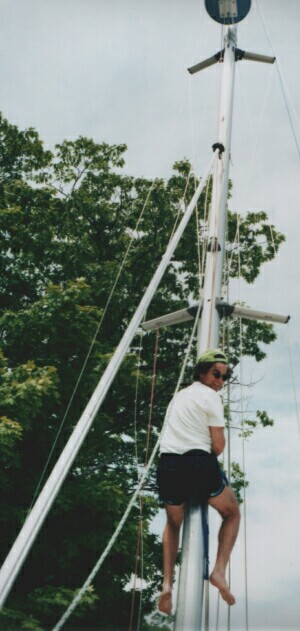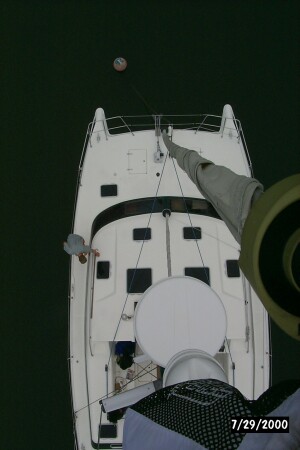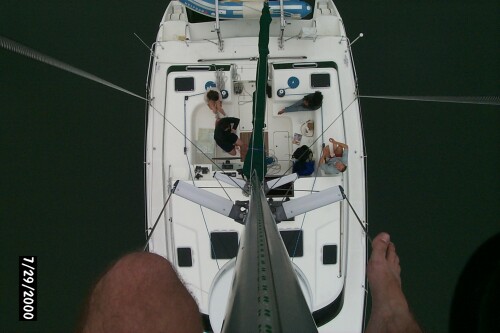Going Aloft

Here you can see me preparing to ascend the mast. I've done a bit of rock-climbing in the past and purchased a climbing harness and a bosuns chair. Here I'm only using the climbing harness. Two halyards and two locking carabines held me - one to pull me up, the other to belay me. You can also see the two loose stay receptacles on the mast next to my shoulder. Despite the angle of the boat and the gradual loss of circulation, I was quite comfortable. |

Barefoot and happy, here I am being pulled up the mast. I'm still pretty low, not having even cleared the first set of spreaders. Note the relaxed pose and the classy headgear. This trip allowed me to inspect the mast head and tighten the furling extrusions. |
 Since Jon Rheaume and Will Hilley went through all the trouble of winching me to the top of the mast, I naturally had to take some pictures from up there. Here is the front of the boat. Below my climbing bag you can see the radar reflector as well as the Furuno radar transmitter/receiver. I have yet to understand why more and more sailing vessel owners are starting to mount radars on stern poles. As paranoid as people are about minute microwave leakage around home appliances its pretty funny to see 4kW units mounted scarcely above head level. Never mind that radars are primarily limited by the line of sight... So you'll do little more than heat some water around you.
Since Jon Rheaume and Will Hilley went through all the trouble of winching me to the top of the mast, I naturally had to take some pictures from up there. Here is the front of the boat. Below my climbing bag you can see the radar reflector as well as the Furuno radar transmitter/receiver. I have yet to understand why more and more sailing vessel owners are starting to mount radars on stern poles. As paranoid as people are about minute microwave leakage around home appliances its pretty funny to see 4kW units mounted scarcely above head level. Never mind that radars are primarily limited by the line of sight... So you'll do little more than heat some water around you.
The only advantage that mounting radar transmitters close to the waterline brings you is better resolution at short range and perhaps better ease of maintenance. Given that our Furuno unit never needed maintenance, I doubt this is a big consideration to keep in mind. The better resolution is a good feature for those that frequently use radar to navigate in narrow channels with lots of closely spaced buoys and the like. We don't.
One of the nice features of cruising catamarans is their stability and
resistance to heeling. Thus, radar transmitters don't have to be gimballed
mounted and VHF antennas can take advantage of a higher gain without breaking
up transmissions.
Here is the rear of the boat.

Because the mast is stepped as far back as it is, all control lines naturally fall into the cockpit. This can lead to a mess at times but is very safe in nasty conditions. Barely visible is the dinghy hanging of its davits at the top of the picture. The key thing is to furl the genoa early as its lines can easily whip into the cockpit. Rely on a reefed main and secondary jib instead.


